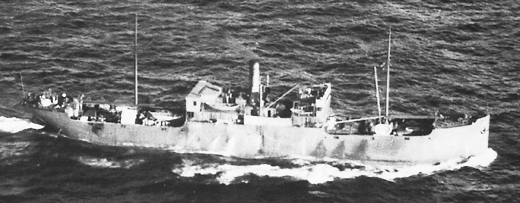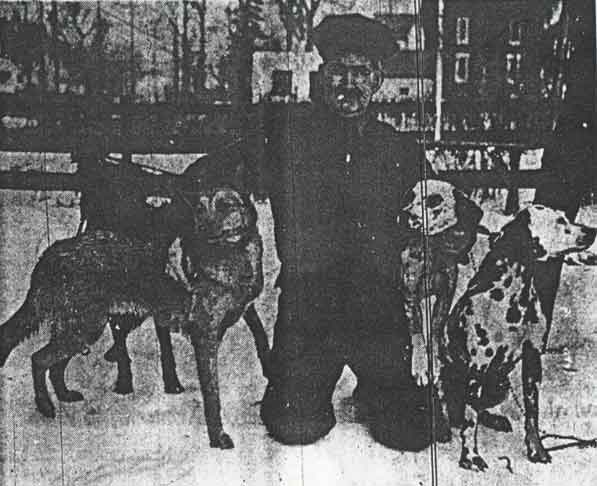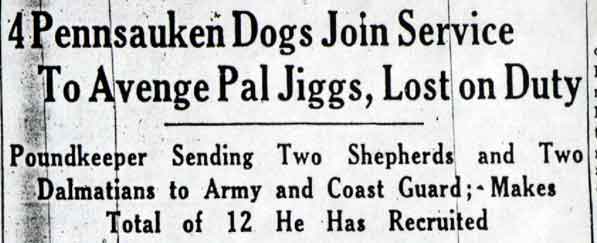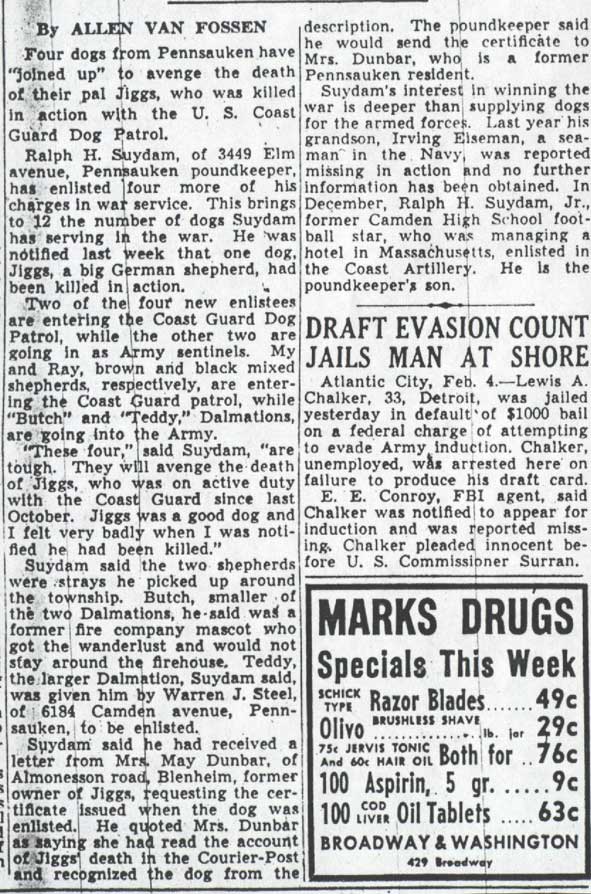|
|
|
|
|
SEAMAN SECOND CLASS IRVING EISENMAN was the eldest child of Irving and Margaret Eisenman. His father had served in World War I. At the time of the 1930 Census, the Eisenman's were renting a home at 2121 Browning Road in Pennsauken NJ. The elder Eisenman was working as a radio technician at the RCA plant in nearby Camden NJ. At the time of the census, the family included Irving, known to family and friends as Buster, brother Robert, and sister Margaret Elaine. Another brother, Douglas, was born after the census was taken. After the birth of Douglas, Margaret Eisenman was killed in an automobile accident while riding in the rumble seat of a car. Irving "Buster" Eisdnman and his brother Bobby went to live with their maternal grandparents, Ralph Henry and Margaret Blakely Suydam, at 3449 Elm Avenue, in Pennsauken NJ. Irving Eisenman enlisted in the United States Navy in September of 1941. He received his basic training at Pensacola FL. He subsequently was assigned to the crew of the USS ATIK (AK-101), The ATIK was a Q Ship, that is, she was a disguised freighter carrying heavy armaments (four 4-inch guns, four .50-caliber machine guns, four .30-caliber Lewis machine guns, and six depth charge projectors). Her mission was to lure German submarines into attacking her, then to respond with her concealed weapons. The ATIK had been the Carolyn , a small freighter that had been in service since 1912. The theory was that a submarine would not waste a torpedo on such a small and old target, but would come to the surface to attack, allowing the crew on board an opportunity to respond. The Carolyn's sister ship, the Evelyn , was also converted into a Q Ship, and named the USS Asterion. Commissioned on March 5, 12942, the ATIK underwent brief sea trials, and with her sister ship the USS ASTERION, sailed from Portsmouth NH on March 23, 1942. Steaming South, she was approximately 300 miles east of Norfolk VA on the night of March 26-27, 1942. Shortly after midnight on March 27, 1942 the USS ATIK was torpedoed by the German submarine U-123. The crew of the ATIK responded with machinegun fire, but after the ship was hit by second torpedo from U-123, ATIK exploded. Although the crew had been seen taking to lifeboats before the explosion, no survivors were recovered from the heavy seas encountered by rescue craft. Seaman Eisenman was reported missing in action on April 5, 1943. |

|
The USS
Asterion AK-123
Sister ship to the USS ATIK |
|
USS Atik (AK-101)Related Resource: History of Q-ships A
double star in the constellation Perseus; the name itself is a shortened
version of the Arabic
al-Atik
. Carolyn- -a steel-hulled, single-screw steamer--was laid down on 15 March 1912 at Newport News, Va., by the Newport News Shipbuilding and Dry Dock Co., for the A. K. Bull Steamship Lines; launched on 3 July 1912; sponsored by Miss Carolyn Bull (for whom the ship was probably named), a granddaughter of the shipping firm's owner, Archibald Hilton Bull (1847-1920); and delivered on 20 July 1912. Carolyn had a sister ship, the Evelyn , which was built at Newport News at the same time she was. For the next 30 years, Carolyn carried freight and passengers between the West Indies and ports on the eastern seaboard of the United States. During World War 1, she received a main battery of a 3-inch and a 5-inch gun, and a Navy armed guard detachment served in the ship from 28 June 1917 to 11 November 1918. During that time, too, the Navy gave her the identification number (Id. No. 1608), but did not take her over for naval service. Carolyn pursued her prosaic calling under the house flag of the Bull Line through the Japanese attack on Pearl Harbor. However, soon after that tragic action, events transpired which had a fateful effect upon the ship. By 12 January 1942, the British Admiralty's intelligence community had noted a "heavy concentration" of U-boats off the "… North American seaboard from New York to Cape Race" and passed along this fact to the American Navy. That day, U-113 under Kapitanleutnant Reinhard Hardegen, torpedoed and sank the British steamship Cyclops , inaugurating Operation "Paukenschlag," (literally, "roll on the kettledrum") and commencing a veritable "blitz" against Allied coastal shipping between New York harbor and the Outer Banks. U-boat commanders found peacetime conditions prevailing along the coast: towns and cities were not blacked-out and navigational buoys remained lighted; shipping followed normal routines and "carried the normal lights." "Paukenschlag" had caught the United States unawares. Committed to fighting the rampaging Japanese in the Pacific and to assuring the safe arrival of vital convoys to Great Britain in the Atlantic, the American Navy could spare few ships to deal with this new threat close to our shores. As a result of the crisis, it launched a new, imaginative, and daring program. Because of the secret nature of the project, its inception is shrouded in mystery. It appears that President Franklin Roosevelt, well known for his affinity for things novel and naval, desired that the Navy establish a "Q-ship" program similar to that which had been used by the British with some success in the first World War. Acquired by the Navy from the Maritime Commission, Carolyn steamed to Portsmouth, New Hampshire, where she was turned over to the Navy under a bareboat charter at 1530 on 12 February 1942. This followed within two weeks of a dispatch from the Chief of Naval Operations dated 31 January 1942 which had stated his desire that Evelyn and Carolyn "be given a preliminary conversion to AK (cargo ship) in the shortest possible time." A letter from the Chief of the Bureau of Ships elaborated on the "shortest possible time," when it stated on 12 February that the conversion and outfitting of the vessels was desired "by 1 March 1942." As could be expected, the process of converting two venerable tramp steamers into men-of-war was by no means complete; but, over the next few weeks, the two erstwhile "tramps" were given their main and secondary batteries and sound gear. Nevertheless, they appeared to be mere cargo ships. Carolyn became Atik , and was given a cargo ship hull number, AK-101; Evelyn became Asterion (AK-100). Atik (AK-101) was placed in commission at 1645 on 5 March 1942 at the Portsmouth (N.H.) Navy Yard, Lt. Comdr. Harry Lynnwood Hicks, USN, in command. Following fitting out and brief sea trials, she and Asterion got underway on 23 March 1942. Soon after leaving port, Atik and Asterion went their separate ways. At the outset, all connected with the program apparently harbored the view that neither ship "was expected to last longer than a month after commencement of [her] assigned duty." Atik 's holds were packed with pulpwood, a somewhat mercurial material. If dry, "an explosive condition might well develop and, if wet, "rot, with resultant fire might well take place." Despite these disadvantages, pulpwood was selected as the best obtainable material to assure "floatability." Atik 's mission was to lure some unsuspecting U-boat into making a torpedo attack. According to the projected scenario, the submarine, having deemed the venerable tramp unworthy of the expenditure of more torpedoes, would surface to sink the crippled foe with gunfire. The plan presupposed a "backup" which was to come to the rescue whenever a "Q-ship" ran into difficulties. In March, 1942, though, there was no such "safety net." "The commanding officers of the two ships ( Atik and Asterion ) were told [that] they could expect little help if they got into trouble as the situation was critical. Every available combatant ship and plane were [sic] being employed to the maximum for convoy and patrol duties." In the gathering darkness, three days after Atik had sailed from Portsmouth, she attracted the attention of the German submarine, U-123 , under the command of Kapit�nleutnant Reinhard Hardegen, on her second war patrol off the eastern seaboard. The U-boat, on the surface, began stalking Atik at 2200, and at 0037 on 27 March fired one torpedo from 700 yards away which struck the ship on her port side, under the bridge. Fire broke out immediately, and the ship began to assume a slight list; an SOS went out from the crippled "freighter": "S.S. Carolyn , torpedo attack, burning forward, not bad." As U-123 proceeded around under her victim's stern, her captain, Kapitanleutnant Hardegen, duly noted one boat being lowered on the starboard side and men abandoning ship. "Carolyn" was not dead--yet. After U-123 turned to starboard, Atik gathered steerage way, paralleling her course by turning to starboard as well, and dropped her concealment, commencing fire from her main and secondary batteries. The first shell dropped short of the U-boat, as she made off presenting a small target; the others were off in deflection. A veritable hail of .50-caliber machine gun fire, though, ricocheted around the U-boat's decks as she bent on speed to escape the trap into which Hardegen had fallen. One bullet mortally wounded a midshipman standing watch on U-123's bridge. Gradually, the U-boat pulled out of range behind the cover of a smoke screen emitted by her straining diesels, and her captain assessed the damage. As he later recorded, "We had been incredibly lucky." Not so, Atik . U-123 submerged and again approached her daring opponent. At 0229, the U-boat loosed a torpedo into Atik 's machinery spaces. Satisfied that this blow would prove to be the coup de grace , U-123 stood off to await developments as Atik settled by the bow, her single screw now out of the water. Once again, Atik 's crew could be seen embarking in her boats, as their ship clung stubbornly to life. U-123 surfaced at 0327, perhaps to finish off the feisty Q-ship once and for all. Suddenly, at 0350, a cataclysmic explosion blew Atik to pieces. Ten minutes later, U-123 buried her only casualty--the midshipmen killed by Atik 's machine gun fire. Atik 's entire crew perished--either in the blast or during the severe gale that lashed the sea soon after the ship disintegrated. The next morning, an Army bomber was dispatched to Atik 's last reported location but found nothing. The destroyer Noa (DD-343) and the tug Sagamore (AT-20) steamed toward the area as well. Heavy seas forced Sagamore to return to port, but Noa remained in the vicinity and ultimately sighted wreckage from Atik . Asterion , too, had heard her sister ship's cry for help and plodded to the scene, Lt. Comdr. Legwen deeming his orders "sufficiently broad to proceed immediately to her assistance," but Asterion encountered casualties to her steering gear, and only continued the search for 24 hours before being forced to put into Hampton Roads for repairs. On 9 April, Radio Berlin reported that a U-boat had sunk an adversary after a "bitter battle," but gave no details. It was not until after the war that translated German records shed light on what had become of Atik . |
USS AtikFrom Wikipedia, the free encyclopedia. USS Atik (AK-101) was a Q-ship of the United States Navy named for al-Atik, a double star in the constellation Perseus. See also her twin sister ship, USS Asterion (AK-100). The steel-hulled, single-screw steamer Carolyn was laid down on March 15, 1912 at Newport News, Virginia, by the Newport News Shipbuilding and Dry Dock Company, for the A.K. Bull Steamship Lines; launched on July 3, 1912, sponsored by Miss Carolyn Bull (for whom the ship was probably named), a granddaughter of the shipping firm's owner, Archibald Hilton Bull (1847-1920), and delivered on July 20, 1912. For the next 30 years, Carolyn carried freight and passengers between the West Indies and ports on the eastern seaboard of the United States. During World War I, she received a main battery of a three-inch and a five-inch gun, and a Navy armed guard detachment served in the ship from June 28, 1917, to November 11, 1918. During that time, too, the Navy gave her the identification number Id. No. 1608, but did not take her over for naval service. Carolyn pursued her prosaic calling under the house flag of the Bull Line through the Japanese attack on Pearl Harbor. A dispatch dated January 31, 1942, expressed the Chief of Naval Operations' desire that Evelyn and Carolyn "be given a preliminary conversion to AK (cargo ship) in the shortest possible time." A letter from the Chief of the Bureau of Ships elaborated on the "shortest possible time," when it stated on February 12 that the conversion and outfitting of the vessels was desired "by 1 March 1942." Acquired by the Navy from the Maritime Commission, Carolyn steamed to Portsmouth, New Hampshire, where she was turned over to the Navy under a bareboat charter at 1530 on February 12, 1942. As could be expected, the process of converting two venerable tramp steamers into men-of-war was by no means complete; but, over the next few weeks, the two erstwhile "tramps" were given their main and secondary batteries and sound gear. Nevertheless, they appeared to be mere cargo ships. Carolyn became Atik, and was given a cargo ship hull number, AK-101; Evelyn became Asterion (AK-100). They were to use their old identities when communicating with friendly vessels and stations; if enemy ships should challenge, reply should be made in accordance with International Procedure, using the identification SS Vill Franca, of Portuguese Registry, callsign CSBT. Atik (AK-101) was placed in commission at 1645 on March 5, 1942, at the Portsmouth Navy Yard, Lieutenant Commander Harry Lynnwood Hicks, USN, in command. At the outset, all connected with the program apparently harbored the view that neither ship "was expected to last longer than a month after commencement of [her] assigned duty." Atik's holds were packed with pulpwood, a somewhat mercurial material. If dry, "an explosive condition might well develop and, if wet, "rot, with resultant fire might well take place." Despite these disadvantages, pulpwood was selected as the best obtainable material to assure "floatability." Atik's mission was to lure some unsuspecting U-boat into making a torpedo attack. According to the projected scenario, the submarine, having deemed the tramp unworthy of the expenditure of more torpedoes, would surface to sink the crippled foe with gunfire. The plan presupposed that supporting forces would come to the rescue whenever a Q-ship ran into difficulties. In March 1942, though, there was no such reserve available. The commanding officers of the two ships were told that they could expect little help if they got into trouble. Every available combatant ship and plane was employed in convoy and patrol duties. Following fitting out and brief sea trials, she and Asterion got underway on March 23, 1942. Soon after leaving port, Atik and Asterion went their separate ways. On the night of March 26-27, Atik was cruising about 300 miles east of Norfolk, Virginia and Asterion was cruising some 240 miles to the south of this area. At 1945 (Eastern War Time, UT+4—note that some accounts use German Winter Time, UT-1) on the night of March 26, the Duty Officer in the Joint Operations Control Room, Eastern Sea Frontier (ESF), was informed that an SOS had been picked up from an unidentified ship which had been torpedoed. Nothing further. Atik had attracted the attention of U-123, on her second war patrol off the eastern seaboard. The U-boat, on the surface, began stalking Atik at 1700, and at 1937 fired one torpedo from 700 yards away which struck the ship on her port side, under the bridge. Fire broke out immediately, and the ship began to assume a slight list. At 2053, radio stations at Manasquan, New Jersey, and at Fire Island, New York, intercepted the distress message:
Two minutes later, a second distress message further amplified:
As U-123 proceeded around under her victim's stern, her captain, Kapit�nleutnant Reinhard Hardegen, noted one boat being lowered on the starboard side and men abandoning ship. Because such attacks were a regular occurrences at this time and because all available surface craft were on patrol the dispatch from Carolyn produced no immediate action. The Duty Officer in the Control Room had not been informed as to the secret nature of Carolyn, and consequently his only action was to forward the dispatch to Commander-in-Chief, United States Fleet (Cominch). "Carolyn" was not out of the fight. After U-123 turned to starboard, Atik gathered steerage way, paralleling her course by turning to starboard as well, and dropped her concealment, commencing fire from her main and secondary batteries. The first shell dropped short of the U-boat, as she made off presenting a small target; the others were off in deflection. A hail of .50-caliber machine gun fire, though, ricocheted around the U-boat's decks as she bent on speed to escape the trap into which Hardegen had fallen. One bullet mortally wounded a midshipman standing watch on U-123's bridge. Gradually, the U-boat pulled out of range behind the cover of a smoke screen emitted by her straining diesels, and her captain assessed the damage. As he later recorded, "We had been incredibly lucky." U-123 submerged and again approached her opponent. At 2129, the U-boat shot a torpedo into Atik's machinery spaces. Satisfied that this blow would be fatal, U-123 stood off and watched as Atik settled by the bow, her single screw now out of the water. Once again, Atik's crew could be seen embarking in her boats, as their ship clung stubbornly to the surface. U-123 surfaced at 2227, confident that Atik was no longer a threat, and continued to watch until 2250 when a cataclysmic explosion blew Atik to pieces. Ten minutes later, U-123 buried her only casualty—the midshipmen killed by Atik's machine gun fire. Atik's entire crew perished—either in the blast or during the severe gale that blew up soon after the ship disintegrated. Several hours after receiving the report of the SOS, an officer in Cominch Operations room phoned the Duty Officer and asked if the Commander, Eastern Sea Frontier (CESF), or the Chief of Staff had been notified. They had not. The Duty Officer was informed that they should be, immediately. Because CESF and his Chief of Staff were both in Norfolk on that particular night, the Duty Officer notified the Operations Officer at his home. Early the next morning, an Army bomber was sent to search the area from which Carolyn had sent her distress message; the destroyer USS Noa (DD-343) and the tug USS Sagamore (AT-20) were sent to assist. The Army bomber returned without having sighted anything. The tug and the destroyer encountered such heavy weather that Sagamore was recalled on March 25; Noa searched the area until fuel shortage compelled her to return to New York on March 30. Other flights were unsuccessful until March 30, when two Army planes and one PBY-5A out of Norfolk reported that they had sighted wreckage roughly ten miles south of the original reported position. Asterion had intercepted the distress messages from Atik and proceeded directly to the area, Lieutenant Commander Legwen deeming his orders "sufficiently broad to proceed immediately to her assistance," but Asterion encountered casualties to her steering gear, and only continued the search for 24 hours before being forced to put into Hampton Roads for repairs. The Norwegian freighter SS Minerva was sighted in the vicinity, southbound for St. Thomas, Virgin Islands. On her arrival there, she was boarded and interrogation revealed that her crew had sighted no wreckage and had picked up no survivors. Twelve days later, CESF reported all known details to Cominch on the "suspected sinking of the SS Carolyn," and concluded: "…it is believed that there is very little chance that any of her officers and crew will be recovered. It is therefore recommended that if no further information is received by April 27, they be considered lost and that next of kin be notified." On April 9, Radio Berlin reported that a U-boat had sunk an adversary. The Associated Press distributed the announcement and it was printed in the New York Times the next day.
General Characteristics
|
| Camden Courier-Post - February 4, 1943 |
|
|

|

|

|

|
RETURN TO CAMDEN COUNTY WAR DEAD INDEX